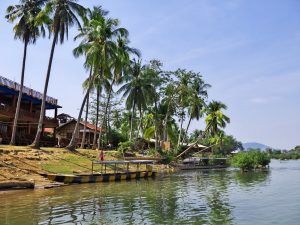Radio Free Asia (RFA) reported this week that officials in Laos will soon take an important step forward on a new hydropower project, the seventh large-scale dam project to be undertaken on the mainstream of the Mekong River.
The report cited an unnamed government official as saying that the authorities were currently preparing the paperwork for the 728-megawatt Phou Ngoy dam, and aimed to submit a formal notification about the project to the Mekong River Commission (MRC) “at the end of this year.”
The $2.4 billion project is being developed by Thailand’s Charoen Energy and Water Asia (CEWA) and if approved, will be built by two South Korean construction companies: Korea Western Power (KOWEPO) and Doosan Heavy Industries & Construction. If approved, the project is slated to be completed in 2029.
The Phou Ngoy project, which would be located about 18 kilometers north of Pakse, the capital of Champassak province in southern Laos, is just one of a cascade of large dam projects planned on the mainstream of the Mekong River, which form the centerpiece of Vientiane’s plan of transforming the landlocked nation into the “battery of Southeast Asia.” According to RFA, it is the seventh of nine planned projects on the mainstream of the Mekong. Two dams – Don Sahong and Xayaburi – have so far been completed.
According to a February 2021 report in a hydropower industry publication, CEWA has conducted an initial feasibility study and the environmental impact assessment into the Phou Ngoy dam, the results of which it presented to the Lao government in February 2020. However, the government has not yet notified the MRC about the project.
This notification is a mandatory step for any Mekong River developments undertaken by the MRC members, which in addition to Laos also includes Vietnam, Thailand, and Cambodia, and would begin a six-month process of “prior consultation” during which “technical evaluation and formal consultations” are done over the benefits and risks of any proposed water-use project.
The government of Laos is said to be bent on pressing ahead with its hydropower plans, despite the increasing consternation about the impact of mega-dams on the ecology of the Mekong River basin. In March 2020, Cambodia announced a 10-year moratorium on the construction of new Mekong dams.
In January 2021, Thailand rejected a technical report on the Sanakham hydropower project. The Thai Ministry of Energy, which felt the country had an oversupply of power, said it might refuse to purchase electricity produced by the dam. Given that the Phou Ngoy project will also likely be reliant on Thai purchases of power, this could also conceivably become a factor further on in the approval process.
While lower Mekong nations are slowly becoming more leery about disruptive hydropower projects, the MRC has no power to veto them. This has led critics to charge that the MRC’s elaborate process of technical consultation has done little to ensure that river developments, particularly dams, serve the interests of the region’s peoples. According to RFA, the project will affect 88 villages in the immediate vicinity.
In early 2021, I wrote that Laos’ hydropower plans appear to have become “untethered from any solid economic rationale, driven overwhelmingly by the domestic interests that stand to benefit from dam construction.” This latest approval seems to confirm that assessment.

































